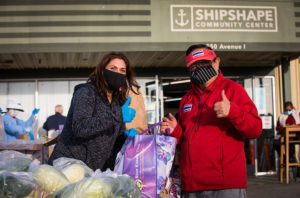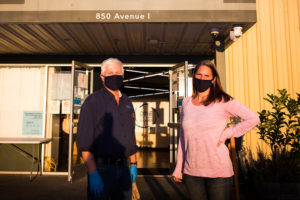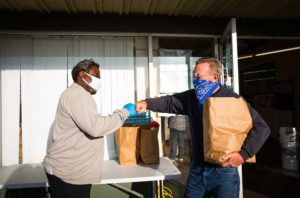 When you cross the Bay Bridge by car or bus, you’ve probably noticed an exit right before the I-80 freeway continues to the East Bay, one that heads toward Treasure Island. If you took that exit, you’d find yourself on a human-made island that’s less than a mile wide and comprised of a few thousand residents.
When you cross the Bay Bridge by car or bus, you’ve probably noticed an exit right before the I-80 freeway continues to the East Bay, one that heads toward Treasure Island. If you took that exit, you’d find yourself on a human-made island that’s less than a mile wide and comprised of a few thousand residents.
What folks may not realize is that due to the island’s isolation, it has dealt with many issues, such as a lack of transportation, health issues from radiation exposure given the island was historically used as a dump, and limited food access.
“If you live here and you don’t have a car, you’re really restricted with taking a bus or paying for an Uber,” said Amanda Scharpf, a resident for seven years. “One of the biggest restrictions is if you can’t find something at the only market we have here, then you kind of have to haul it yourself all the way from downtown San Francisco.”
Limited Food Access
 Treasure Island didn’t even have a grocery store until 2012 when the Island Cove Market opened. Unfortunately, not everyone can afford to purchase food there.
Treasure Island didn’t even have a grocery store until 2012 when the Island Cove Market opened. Unfortunately, not everyone can afford to purchase food there.
To address this lack of food access, the nonprofit One Treasure Island, with the help of the Food Bank, has hosted a neighborhood food pantry at the Ship Shape Community Center for more than 20 years.
Every Tuesday, both volunteers and staff members come together in front of the community center and pack bags with fresh produce such as apples and lettuce, as well as meat or eggs and loaves of bread to give out to the participants who live on the island. Once the pantry opens, over 200 participants (up from over 85 participants before the pandemic), arrive by car or walk on over from their homes, and are enthusiastically greeted by the volunteers and staff. Some of the participants even stay to catch up and hear what others have been up to after grabbing their weekly bags of groceries.
Since the start of the pandemic, Amanda, who also manages the pantry, has seen an increase in the number of people using One Treasure Island’s services. Previously, many pantry participants worked in the restaurant industry; an industry heavily impacted by COVID. With many restaurants closing their doors temporarily or for good, around 117,000 jobs in the hospitality industry were lost in California during December alone.
“We’ve had people come to sign up for the pantry and they’ve even said, ‘I used to work for this restaurant, and they just completely closed down, and I don’t know what I’m going to do.’ This has impacted many people,“ shared Amanda.
Providing Access for All
 Dave, a participant for over ten years, previously worked in landscaping and was barely getting by on his salary when he started coming to the pantry. He now works for the city and knows everyone at the pantry.
Dave, a participant for over ten years, previously worked in landscaping and was barely getting by on his salary when he started coming to the pantry. He now works for the city and knows everyone at the pantry.
“The food pantry really saved my life,” he said. “[Otherwise] I’d be eating a lot more noodles.”
For some newer residents of Treasure Island, like Rickey, formerly incarcerated, coming to the pantry is the only choice for fresh food.
“This makes it a lot easier for us. Right now, we don’t qualify for benefits like food stamps, so it means a lot to us,” said Rickey.
Others like Mike, a long-time volunteer and participant who knows everyone living on the island, see the pantry as a tight-knit community that continues to be resilient during unprecedented times.
“I used to like the closeness; everyone on the island is my friend,” he said. “Now, you can’t get close [due to COVID]. It’s sad.”
Staying Hopeful
While the pantry is still the only option for many, Amanda stays hopeful for the future.
“At the beginning of COVID, we had lines around the block, and it was just nice to see that we can provide families with something that meant a lot to them,” said Amanda. “It’s always heartwarming when people show up with their kids because you get to know the kids too. It’s been very helpful, especially for the families. Living here on this island, I really felt like the community has come together a lot more in the last few months.”



Share